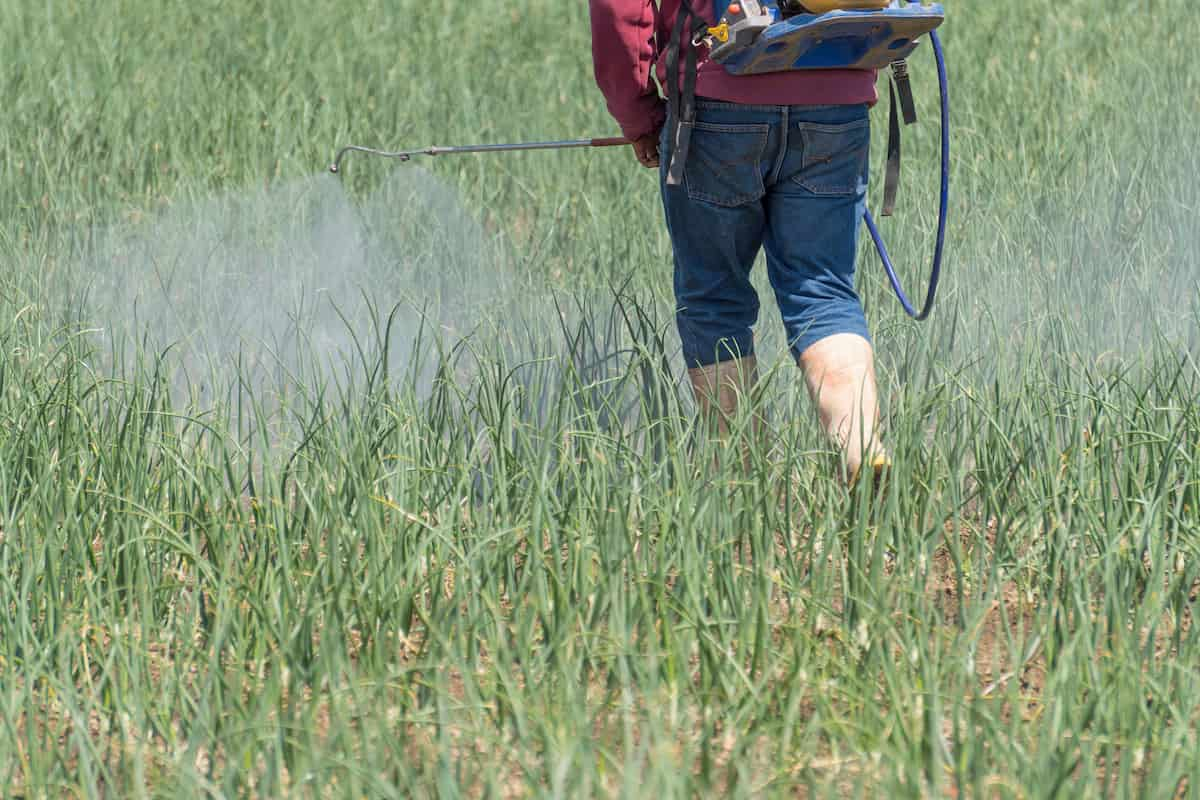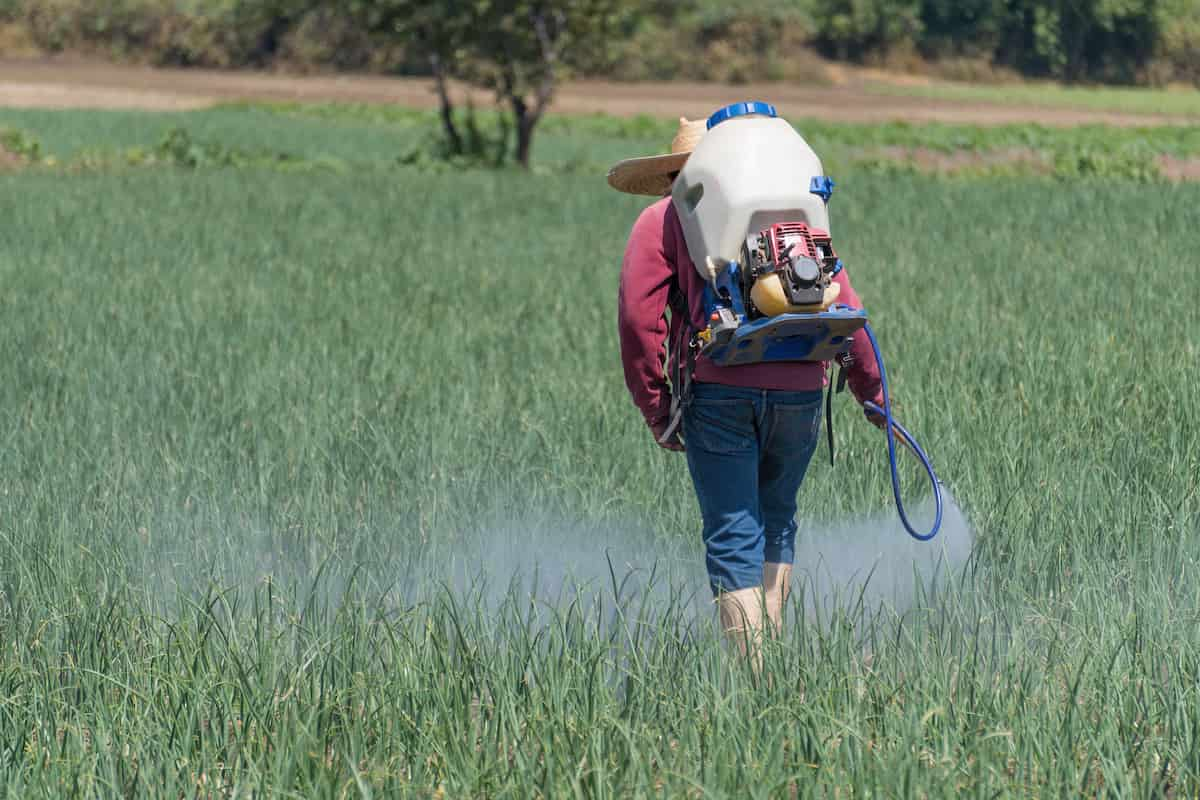Purple Blotch is a fungal disease that can cause significant damage to onion crops. The disease manifests as purple or brownish-purple lesions on the leaf stem and bulbs and is caused by the fungus Alternaria porri. The fungus spores can survive in soil, plant debris, and infected onion bulbs, making it a challenging disease to manage. Crop rotation and disease-resistant onion varieties can also be effective management strategies. In severe cases, fungicides may be necessary but should be combined with other management strategies for best results.

Purple Blotch Management in Onion
What is Purple Blotch in Onion?
- Purple Blotch is a fungal disease that affects onions, causing purple or brownish-purple lesions on the leaves, stems, and bulbs.
- The disease is caused by the fungus Alternaria porri, which thrives in warm and humid conditions.
- The fungus spores can survive in soil, plant debris, and infected onion bulbs, infecting new crops.
- Purple Blotch can cause significant yield losses in onions, as infected plants may produce smaller bulbs.
Onion Plant Details
- Onion (Allium cepa) is a biennial plant that is grown as an annual crop.
- The plant produces a bulb that is used as a culinary ingredient and also has medicinal properties.
- Onions are a cool-season crop typically grown in the fall or winter in temperate regions or in the spring in colder regions.
Causes/Pathogen of Purple Blotch in Onion
- Purple Blotch in onions is primarily caused by the fungus Alternaria porri. This disease is prevalent in warm and humid regions where onions are grown.
- The fungus can also affect other plants in the Allium family, such as garlic and leeks. Long-day onion cultivars, especially sweet Spanish onions, are more susceptible to the disease than common yellow cultivars.
- All short-day cultivars are also susceptible. The fungus can survive in soil and plant debris, infecting new onion crops, and can also be transmitted through infected seedlings or bulbs used for planting.
The Disease Cycle of Purple Blotch in Onion
- The disease is soil-borne, and the fungus can survive in soil, infected bulbs, plant debris, and even on the roots of weeds.
- The pathogen overwinters in crop residue or the soil surface, and spores are produced during warm and humid weather.
- Symptoms of Purple Blotch appear 1-4 days after infection, and new lesions produce black spores within five days.
- Spores are produced at night and released in the morning when humidity decreases, and they are spread by wind, splashing rain, or irrigation.
- Lesions typically occur when the leaf wetness lasts 16 hours or more, and flecking may occur at 12 hours.
- Purple Blotch and Stemphylium leaf blight can sometimes occur on the same plant, but microscopy is necessary to distinguish between the fungi.
Conditions Favorable for Purple Blotch Spread in the Field
- Purple Blotch disease thrives in hot and humid weather, with temperatures ranging from 21-30°C.
- High relative humidity (between 80-90%) also creates favorable conditions for the disease to develop and spread.
- The fungus that causes Purple Blotch can survive in the soil for several years, making crop rotation an important management strategy.
- Overcrowding onion plants in the field can also increase the Purple Blotch infection. Poor air circulation in the field can also contribute to the development and spread of the disease.
In case you missed it: Damping Off Management in Onion: Symptoms, Treatment, Chemical, Biological, and Organic Control

Damage Symptoms of Purple Blotch
- Small, sunken, water-soaked lesions on older leaves with light centers
- Enlarged lesions that turn purple to brown, often with yellow rings that create a distinctive bull’s-eye pattern
- Yellowing and wilting of leaves, which may be encircled
- Increased susceptibility of younger leaves as the bulb matures
- Infection of bulbs through neck wounds
- Reduced yields due to undersized bulbs
- Bulb rot symptoms begin as soft, water-soaked areas, eventually turning dark reddish-purple, then brown/black.
- Diseased bulbs may rot in storage.
The symptoms of Purple Blotch can also occur on flower stalks as small, sunken, whitish flecks with purple-colored centers, which may girdle the stalk and cause drooping. In severe cases, infected plants may fail to develop bulbs altogether.
Yield Loss Due to Purple Blotch on Onion
- Purple Blotch, caused by the fungus Alternaria porri, can cause significant yield losses in onion crops.
- Yield losses due to Purple Blotch can approach 25%, resulting in lower-quality or smaller bulbs.
- The disease affects the tops and bulbs of onions and related crops and is prevalent in onion-growing regions of the Midwest.
- The fungus spores can survive in soil, plant debris, and infected onion bulbs, making them difficult to manage.
Purple Blotch Management in Onion by Cultural Method
- Crop rotation is a cultural method that can help to manage Purple Blotch in onion crops. Avoid planting onions in the same field for at least three years.
- Planting disease-resistant onion varieties can also be effective, as these varieties are less susceptible to Purple Blotch infection.
- Proper spacing between plants can also reduce humidity levels and limit the spread of the disease.
- Good crop management practices, such as removing infected plant debris and weeds, can also help prevent the disease’s spread.
Purple Blotch Management in Onion by Biological Method
- Biological control is an alternative approach for managing Purple Blotch in onion crops. At the same time, there are currently no effective biological control agents for this disease, with certain fungi as antagonists against the pathogen Alternaria porri.
- The fungus Cladosporium herbarum has been shown to inhibit the growth of Alternaria porri on contact in vivo, resulting in a 66.6% reduction in infection.
- Other fungi, such as Penicillium sp., were less effective, with a 54% reduction in infection. Using a mixture of several antagonists can lead to a reduction in infection of up to 79.1%.
Purple Blotch Management in Onion by Chemical Method
- Protective fungicides are the most effective method of managing Purple Blotch in commercial onion crops.
- Fungicides containing boscalid, chlorothalonil, fenamidone, and mancozeb can be applied preventatively at fortnightly intervals, starting one month after transplanting.
- Copper fungicides are also registered for use but are not highly effective. It’s important to alternate the use of fungicides from different families to prevent the development of resistance in the pathogen.
Purple Blotch Management in Onion by Organic Method
- Organic methods of managing Purple Blotch in onions involve using natural products and practices to control the disease.
- One method is crop rotation and avoiding planting onions in the same location for at least three years.
- Another method is to use disease-resistant onion varieties, which can be found at many organic seed suppliers.
- In addition, organic fungicides made from natural ingredients, such as copper-based products, can be used to control the disease.
- Recent development has also shown that aqueous extracts of Azadirachta indica (Neem) and Datura stramonium (jimsonweed) can be effective biocontrol agents against Purple Blotch in onions.
- While no commercial products are available yet, these natural extracts could be promising alternatives to traditional fungicides in the future.
Preventive Measures for Control of Purple Blotch
- Preventing Purple Blotch in onion crops requires a combination of cultural and management practices. Using certified seeds, choosing resistant varieties, and planting early in the season can help reduce the risk of infection.
- Plowing fields, increasing plant spacing, fertilizing generously, controlling weeds, removing debris, and avoiding plant injuries are effective preventive measures.
- Crop rotation of 2-3 years is recommended, as is controlling onion thrips. Bulbs in a well-aerated cooler should be stored at 1-3°C with 65-70% humidity.
In case you missed it: Banana Anthracnose Disease Management: Symptoms, Treatment, Chemical, Biological, and Organic Control

Conclusion
Purple Blotch is a serious fungal disease that can cause significant damage to onion crops. Effective management requires a combination of cultural practices, fungicides, and biological control measures. Early detection and management are key to minimizing the impact of the disease.
- Deworming Schedule for Dogs/Puppies: A Beginners Guide
- How to Prevent and Control Parasites in Goats
- Beneficial Insects in Pest Management
- Natural Solutions for Pest Control in Flower Gardens
- Types of Fungicides Used in Agriculture
- Common Issues in the Fruit Development Stage of Pomegranate Farming
- Fruit Development Issues in Papaya: Easy Solutions and Treatment
- Soil-Borne Diseases and How to Protect Your Plants
- Practices to Prevent Disease Spread in the Garden